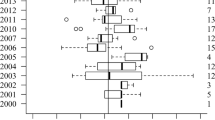Abstract
In spring 1995 (Feb.–May) I observed seven pairs of Raven in southern Germany on the “Schwäbischen Alb”. The aim was to record parental expenditure for rearing nestlings. Expenditure was assessed by recording the activities of the adults at their nest (mainly brooding and feeding the offspring) and was analysed with respect to the number of nestlings per brood and with respect to the weather. Pairs with more than one nestling saved effort by stopping brooding their offspring at a lower nestling age. Also brooding was less dependent on the ambient temperature for pairs with more than one nestling than for pairs with only one nestling. The feeding frequency per nestling has been lower, if there were more nestlings to feed. The total frequency of feeding increased with increasing number of nestlings per brood. The effort for the hygiene of the nest was independent upon the number of offspring per nest. Nevertheless, pairs with more than one nestling spent time for comfort behaviour. Thus, it was more effective to reare more than one nestling at a time.
Zusammenfassung
Im Frühjahr 1995 (Febr.–Mai) wurden auf der Schwäbischen Alb 7 Kolkrabenpaare beobachtet. Ziel der Untersuchung war es den Aufwand der Altvögel für die Jungenaufzucht zu erfassen. Der Aufwand wurde über die Aktivität der Altvögel am Nest abgeschätzt und bezüglich der Jungenzahl und des Wetters ausgewertet. Paare, die mehrere Junge hatten, sparten beim Hudern Kosten ein, da sie ihre Jungen bis zu einem geringeren Alter hudern mußten und weniger stark von der Temperatur abhängig waren. Bei den Fütterungen verringerte sich die Fütterfrequenz pro Jungvogel mit zunehmender Jungenzahl, die absolute Anzahl an Fütterungen nahm jedoch zu. Der Aufwand für die Nesthygiene war unabhängig von der Jungenzahl. Selbst bei mehreren Jungen blieb Zeit für Komfortverhalten. Jungenaufzucht war also effektiver, wenn mehrere Jungen gleichzeitig aufgezogen wurden.
Similar content being viewed by others
Literatur
Bezzel, E., &R. Prinzinger (1990): Ornithologie. Stuttgart.
Bortz, J. (1993): Statistik für Sozialwissenschaftler. Berlin, N. Y., London.
Clutton-Brock, T., &Ch. Godfray (1995): Parental investment. In:Krebs, J. R., &N. B. Davis, Behavioural ecology. London.
Gothe, J. (1961): Zur Ausbreitung und Fortpflanzung des Kolkraben (Corvus corax) unter besonderer Berücksichtigung der Verhältnisse in Mecklenburg. In:Schildmacher, H. (1961): Beiträge zur Kenntnis deutscher Vögel. Jena.
Gwinner, E. (1964): Untersuchungen über Ausdrucks- und Sozialverhalten des Kolkraben. Z. Tierpsychol. 21: 657–748.
Ders. (1965): Beobachtungen über Nestbau und Brutpflege des Kolkraben in Gefangenschaft. J. Orn. 106: 145–178.
Henger, R. E., &J. C. Wingfield (1987): Effects of brood-size manipulations on parental investment, breeding success and reproduktive endocrinology of house sparrows. Auk 104: 470–480.
Lamprecht, J. (1992): Biologische Forschung: von der Planung bis zur Publikation. Parey. Berlin, Hamburg.
Masman, D., Dijkstra, C., Daan, S., &A. Bult (1989): Energetic limitation of avian parental effort: Field experiment in kestrel (Falco tinnunculus). J. evol. Biol. 2: 435–455.
Nur, N. (1984a): The consequence of brood size for breeding blue tits. I. Adult survival, weight change and cost of reproduction. J. anim. Ecol. 53: 479–496.
Ders. (1984b): Feeding frequencies of nestling blue tits (Parus caeruleus): cost, benefits and a model of optimal feeding frequency. Oecologia 65: 125–137.
Roa, C. R. (1973): Lineare statistische Methoden und ihre Anwendungen. Berlin.
Rice, W. R. (1989): Analysing tables of statistical tests. Evolution 43: 223–225.
Røskaft, E. (1983): Sex-role partitioning and parental care by the RookCorvus frugilegus. Ornis. Scand. 14: 180–187.
Sokal, R. R., &F. J. Rohlf (1995): Biometry: principles and practice of statistics in biological research. N. Y.
Stauss, M. (1992): Reproduktion und Ressourcennutzung bei Blaumeisen (Parus caeruleus): eine Kosten-Nutzen-Analyse. Dipl.-arbeit der Fakultät für Biologie. Tübingen.
Prinzinger, R. (1976): Temperatur- und Stoffwechselregulation der Dohle (Corvus monedula L.), der Rabenkrähe (Corvus c. corone L.) und der Elster (Pica pica L.); Corvidae, Anz. Orn. Ges. Bayern 15: 1–47.
Author information
Authors and Affiliations
Rights and permissions
About this article
Cite this article
Thöni, B. Aufwand für die Jungenaufzucht beim KolkrabenCorvus corax: Einfluß von Jungenzahl und Witterung. J Ornithol 138, 315–324 (1997). https://doi.org/10.1007/BF01651557
Published:
Issue Date:
DOI: https://doi.org/10.1007/BF01651557




